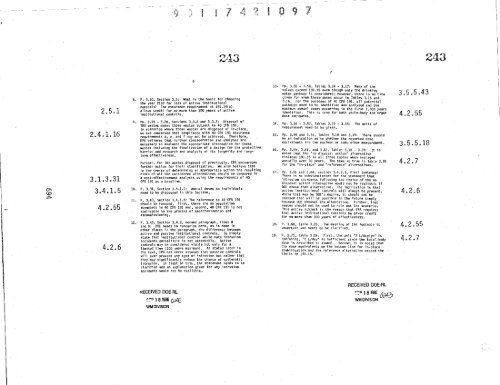EIS-0113_Section_11 - Hanford Site
EIS-0113_Section_11 - Hanford Site
EIS-0113_Section_11 - Hanford Site
Create successful ePaper yourself
Turn your PDF publications into a flip-book with our unique Google optimized e-Paper software.
!<br />
1<br />
1 0<br />
2,13 243<br />
1<br />
4.<br />
4.<br />
8. P. 3.10, <strong>Section</strong> 3.3: What is the basis for choosing<br />
the year 2190 for loss of active institutional<br />
controls? The assurance requirement at 191.14(a)<br />
2.5.1<br />
allows credit for nomore than 100 years of active<br />
inst IIutional controls.<br />
2.4.1.16<br />
6<br />
9. Pp. 3.19 - 3.28, <strong>Section</strong>s 3.3.2 and 3.33: Disposal of<br />
Off wastes makes those wastes subject to 40 CFR 191.<br />
In scenarios where those wastes are disposed of in-place,<br />
we are concerned that compliance with 40 FEW 191 assurance<br />
requirements d, e, and f may not be achieved. Therefore,<br />
EPA believes that further consideration and analyses are<br />
necessary to evaluate the appropriate alternative for these<br />
wastes including the finalization of a design for the protective<br />
barrier and research and analysis of its longevity and longterm<br />
effectiveness.<br />
Further, for TWO wastes disposed of previously, EPA 'encou rages<br />
further action for their stabilization. We also believe that<br />
in the course of determining an appropriate action the resulting<br />
risks of all the considered alternatives should be .compared in<br />
3.<strong>11</strong>.3.31<br />
a cost-effectiveness analysts using the requirements of 40<br />
CFR 191 as a baseline.<br />
3.4.1.5<br />
10. P. 3.34, <strong>Section</strong> 3.4.1.1: Annual doses to individuals<br />
need to be discussed in this <strong>Section</strong>.<br />
<strong>11</strong>. P. 3.43, <strong>Section</strong> 3.4.1.8: The reference to 40 CFR 191<br />
should be removed. First, there are no population<br />
4.2.55<br />
standards<br />
n04<br />
ablett 4 theE processn of decontamination and<br />
decommissioning.<br />
12. P. 3.43, <strong>Section</strong> 3.4.2, second paragraph, lines 8<br />
and 9:. DOE needs to recognize here, as is done is<br />
other places in the paragraph, the difference between<br />
active and passive institutional controls. To simply.<br />
state that institutional control would make intrusion<br />
accidents unrealistic is not acceptable. Active<br />
cantr'ols ma y be considered viable but Only for a<br />
4.2.6 limited rime (100 years m um). As stated later in<br />
the text, EPA has n assumed that passive controls<br />
will ever prevent any type of intrusion but rather that<br />
they may significantly reduce the chance Of systematic<br />
intrusion. In light of this, the statement needs to be<br />
clarified and an explanation given for why intrusion<br />
accidents Mould not be realistic.<br />
13. Pp. 3.55 - 3.58, Tables 3.14 - 3.I7: Many of the<br />
values exceed 191.15 even though only the drinking<br />
wa ter pathway paway is considered; however, there is notime 3 , 5 , 5 . Q 3<br />
given for when these doses occur in Tables 3.15 and<br />
3.16. For the purposes of 40 CFR 191, all potential<br />
pathways Dead to be identified antl aP.1,bed and the<br />
maximum annual doses occurring in the first 1,000 Years<br />
identified. This is true for both wh ol e-boar and Organ 4 , 25 .5<br />
dose estimates.<br />
14. Pp. 3.56 - 3.57, Tables 3.15 - 3.16: . The units of<br />
measurement need to be given.<br />
15. Pp. 3.59 and 3.61, Tables 3.18 and 3.19: There should<br />
be an indication as towhether the reported dose<br />
equivalents are the maximum Or some other measurement.<br />
p<br />
3 .5.5.18<br />
16. Pp. 3.59, 3.61, and 3.62, Tables 3.18 - 3.20: It is<br />
noted that the "no disposal action" alternative<br />
violates 191.15 in all three tables when averaged<br />
annually over 70 years. The same s true in Table 3.20<br />
for the "in-place' and "reference" al t, relatives.<br />
37. Pp. 3.51 and 3.64, section 3.4.2.3, final sentence:<br />
There is no substantiation for the statement that<br />
intrusion accidents following the choice of the no<br />
disposal action alternative eoulo not be realistic If<br />
DOE chose that alternative. The implication is that<br />
4 . 2 . 7<br />
4.2 . 6<br />
active institutional controls Will always be present.<br />
While that may be DOE's desire, it should not be<br />
assumed that will be possible in the future simply<br />
-<br />
because DOE chooses the alternative. Further, that<br />
reasonshould not be used to rule out the scenario.<br />
This entire subject is the reason that EPA requires<br />
that active institutional controls be given credit<br />
for no more than 100 years of effectiveness.<br />
18. P. 3.68, Table 3.26: The meaning of the footnote is 4.2 . 55<br />
uncertain and needs to be clarified.<br />
4 .2.<br />
19. P. 3.70,. Table 3.28: First, the unit "2 L/day/yr" is<br />
Confusing, "2 L/day" is sufficient Since the total-body L<br />
dose is described as annual. Second, it is noted that<br />
the dose equivalents on the bottom line for in-place<br />
stabilization and the reference alternative exceed the<br />
limits in 191.15.<br />
NECEIVED DOE-RL<br />
F-D ) 1818880<br />
WM DIVISION<br />
RECEIVED DOE-RL<br />
`."° 181986<br />
6,10<br />
WM DIVISION

















